-
 Bitcoin
Bitcoin $107,247.2038
-0.18% -
 Ethereum
Ethereum $2,424.7947
0.34% -
 Tether USDt
Tether USDt $1.0003
-0.02% -
 XRP
XRP $2.1171
-3.33% -
 BNB
BNB $645.6618
0.06% -
 Solana
Solana $141.5898
-1.32% -
 USDC
USDC $0.9998
0.00% -
 TRON
TRON $0.2710
-0.41% -
 Dogecoin
Dogecoin $0.1602
-2.99% -
 Cardano
Cardano $0.5553
-2.28% -
 Hyperliquid
Hyperliquid $36.3019
-2.42% -
 Bitcoin Cash
Bitcoin Cash $491.7212
2.04% -
 Chainlink
Chainlink $13.0810
-0.23% -
 Sui
Sui $2.6080
-5.06% -
 UNUS SED LEO
UNUS SED LEO $9.0040
-0.05% -
 Stellar
Stellar $0.2350
-3.06% -
 Avalanche
Avalanche $17.2294
-2.31% -
 Toncoin
Toncoin $2.8075
-1.05% -
 Shiba Inu
Shiba Inu $0.0...01121
-3.43% -
 Litecoin
Litecoin $84.2215
-0.32% -
 Hedera
Hedera $0.1429
-4.88% -
 Monero
Monero $312.2199
-0.90% -
 Dai
Dai $0.9997
-0.01% -
 Ethena USDe
Ethena USDe $0.9999
-0.02% -
 Polkadot
Polkadot $3.2973
-2.60% -
 Bitget Token
Bitget Token $4.4742
3.12% -
 Pi
Pi $0.5631
-10.10% -
 Uniswap
Uniswap $6.7817
-2.06% -
 Pepe
Pepe $0.0...09252
-3.74% -
 Aave
Aave $251.3830
-2.24%
The monthly KDJ low-level golden cross is suitable for mid-term position building?
A monthly KDJ low-level golden cross signals potential bullish momentum, especially when confirmed by volume, price patterns, and other indicators.
Jun 27, 2025 at 03:14 am
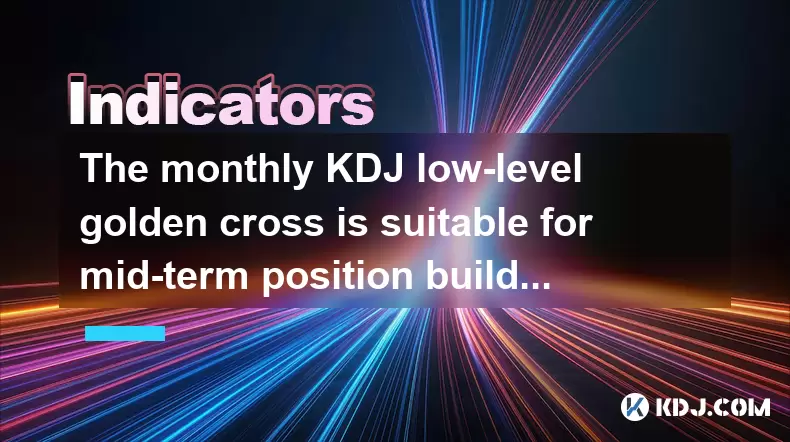
Understanding the Monthly KDJ Indicator
The KDJ indicator, also known as the stochastic oscillator, is a momentum tool widely used in technical analysis within the cryptocurrency market. It consists of three lines: the K line, the D line, and the J line. These lines help traders identify overbought or oversold conditions, potential trend reversals, and entry or exit points.
In the context of monthly chart analysis, the monthly KDJ provides a broader view of price action and long-term momentum. When the K line crosses above the D line at a low level (typically below 20), it forms what is known as a low-level golden cross. This event may signal a shift from bearish to bullish momentum on a macro scale.
Key point:
The monthly KDJ low-level golden cross should not be interpreted in isolation but rather in conjunction with other indicators and price patterns.What Constitutes a Low-Level Golden Cross?
A low-level golden cross occurs when both the K and D lines are below the 20 threshold—indicating an oversold condition—and the K line crosses upward through the D line. This suggests that short-term momentum is beginning to outweigh long-term momentum in a favorable direction.
Unlike regular golden crosses that can occur at any level, the low-level variant carries more weight because it emerges after a significant downtrend or consolidation phase. In the crypto market, where volatility is high, this pattern may hint at the end of a correction or bear cycle.
- Ensure the cross happens below 20
- Confirm that both lines have been trending downward before the cross
- Check for volume or price confirmation alongside the indicator
This setup is particularly relevant for investors seeking mid-term opportunities, as it often precedes multi-week or even multi-month rallies.
Why Mid-Term Position Building Fits This Signal
Mid-term trading typically spans several weeks to months, making it ideal for strategies based on higher time frame indicators like the monthly KDJ. A monthly low-level golden cross may not offer immediate explosive gains but could set the stage for a gradual uptrend that unfolds over time.
Traders who aim to build positions gradually benefit from such signals because they allow entry at relatively safer levels, especially if supported by other confirmations like moving averages or relative strength index (RSI) readings.
- Entry points can be spread out across multiple sessions
- Stop-loss levels can be placed under recent swing lows
- Risk-reward ratios improve with extended holding periods
It's crucial to understand that while this signal may suggest a reversal, it doesn't guarantee one. Hence, position sizing and risk management remain essential components.
How to Validate the Signal Before Entering a Trade
Before acting on a monthly KDJ low-level golden cross, it's important to validate the signal using complementary tools and techniques:
- Look for a closing price above key resistance levels on weekly and daily charts
- Confirm with volume surges or accumulation patterns
- Use on-chain data to assess whether whales or large holders are accumulating
- Monitor market sentiment via social media trends, news cycles, or derivatives data
One effective way to test the validity of the signal is to backtest historical instances where a monthly KDJ golden cross occurred and observe how the asset performed in the subsequent 1–3 months.
For example, during Bitcoin’s 2022 bear market, there were moments when the monthly KDJ formed a low-level golden cross. Those who entered cautiously and layered into positions saw positive outcomes in early 2023.
Practical Steps to Build Mid-Term Positions After the Signal
Once you've confirmed the validity of the monthly KDJ low-level golden cross, the next step is to begin building your position strategically:
- Start with a small initial allocation, say 25% of your intended total exposure
- Add incrementally as the price rises and confirms strength
- Use dollar-cost averaging (DCA) principles to avoid timing pressure
- Set dynamic stop-loss levels based on trailing support zones
Avoid putting all your capital in at once. Instead, treat each rally or consolidation as an opportunity to adjust and rebalance.
Also, consider diversifying across assets that show similar setups, especially if you're dealing with altcoins that follow Bitcoin’s broader trend.
Frequently Asked Questions
Q: Can the monthly KDJ golden cross be applied to altcoins?
Yes, it can be applied to altcoins, but it's more reliable for major ones with sufficient liquidity and historical data. Smaller-cap tokens may produce false signals due to erratic price behavior.
Q: How long should I hold after entering on a monthly KDJ golden cross?
There’s no fixed duration, but mid-term investors usually hold between one to six months, depending on how the trend evolves and whether new sell signals emerge.
Q: Is the monthly KDJ golden cross useful in bull markets?
While it’s more commonly referenced in bear or sideways markets, it can still provide value in bull markets during corrections. However, its effectiveness diminishes if the indicator is already in overbought territory.
Q: Should I ignore the signal if the weekly KDJ isn’t aligned?
Alignment improves reliability. If the weekly KDJ is still bearish while the monthly shows a golden cross, proceed with caution and consider smaller position sizes.
Disclaimer:info@kdj.com
The information provided is not trading advice. kdj.com does not assume any responsibility for any investments made based on the information provided in this article. Cryptocurrencies are highly volatile and it is highly recommended that you invest with caution after thorough research!
If you believe that the content used on this website infringes your copyright, please contact us immediately (info@kdj.com) and we will delete it promptly.
- Ruvi AI vs. Tron: The Race to the $1 Mark and Beyond
- 2025-06-27 06:50:12
- Bitcoin, Ethereum, and Inflation Data: Navigating the Crypto Landscape
- 2025-06-27 06:55:12
- UAE, Crypto, and Trump: A Surprising Intersection in 2025
- 2025-06-27 06:55:12
- BTC Bull Token: Price Prediction and the 50x Potential
- 2025-06-27 06:57:14
- Moonveil's $MORE Token Launching on CEXs: A New Era for Web3 Gaming
- 2025-06-27 06:31:58
- Crypto Presales in 2025: MAGACOIN FINANCE and the Hunt for New Coins
- 2025-06-27 04:50:12
Related knowledge

The monthly KDJ low-level golden cross is suitable for mid-term position building?
Jun 27,2025 at 03:14am
Understanding the Monthly KDJ IndicatorThe KDJ indicator, also known as the stochastic oscillator, is a momentum tool widely used in technical analysis within the cryptocurrency market. It consists of three lines: the K line, the D line, and the J line. These lines help traders identify overbought or oversold conditions, potential trend reversals, and e...
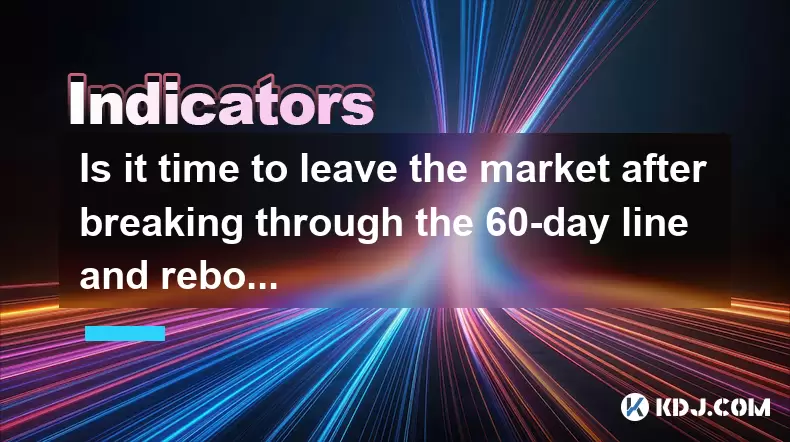
Is it time to leave the market after breaking through the 60-day line and rebounding?
Jun 27,2025 at 06:29am
Understanding the 60-Day Moving Average in CryptocurrencyIn cryptocurrency trading, technical indicators play a pivotal role in decision-making. Among these, the 60-day moving average is widely used by both novice and experienced traders. This indicator calculates the average price of an asset over the last 60 days and helps identify long-term trends. W...
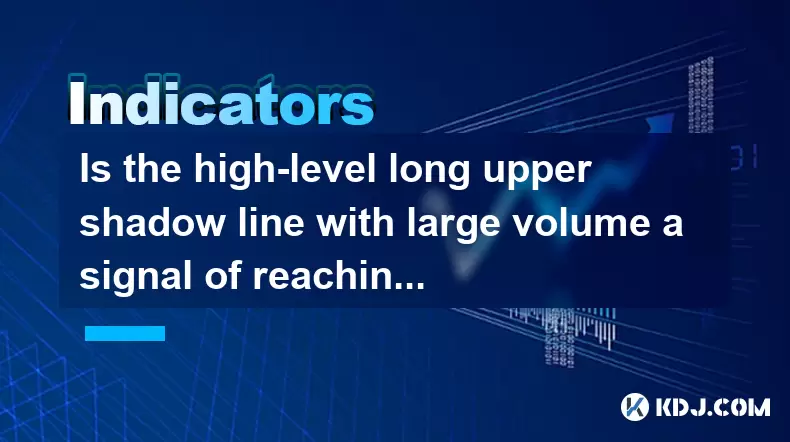
Is the high-level long upper shadow line with large volume a signal of reaching the top?
Jun 27,2025 at 04:50am
Understanding the High-Level Long Upper Shadow LineIn technical analysis within the cryptocurrency market, candlestick patterns play a crucial role in predicting price movements. A high-level long upper shadow line, often referred to as a shooting star or inverted hammer, is a specific type of candlestick pattern that appears at the top of an uptrend. T...
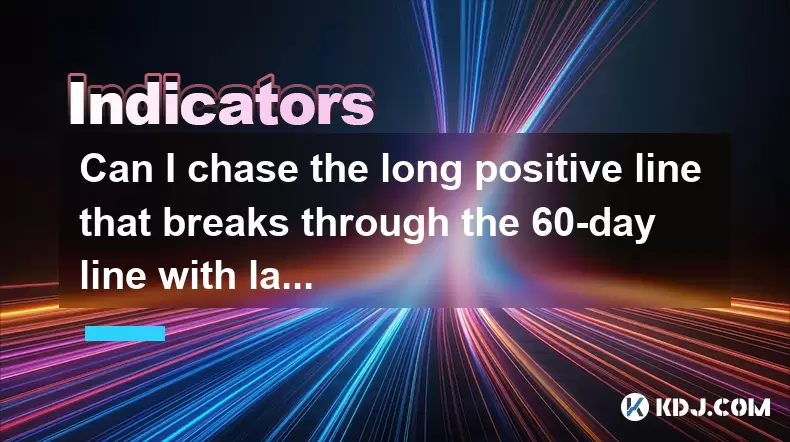
Can I chase the long positive line that breaks through the 60-day line with large volume at the bottom?
Jun 27,2025 at 07:08am
Understanding the 60-Day Line in Cryptocurrency TradingIn cryptocurrency trading, technical analysis plays a pivotal role in identifying potential entry and exit points. One of the commonly used tools is the 60-day moving average, often referred to as the 60-day line. This indicator smooths out price data over the last 60 days and helps traders determin...
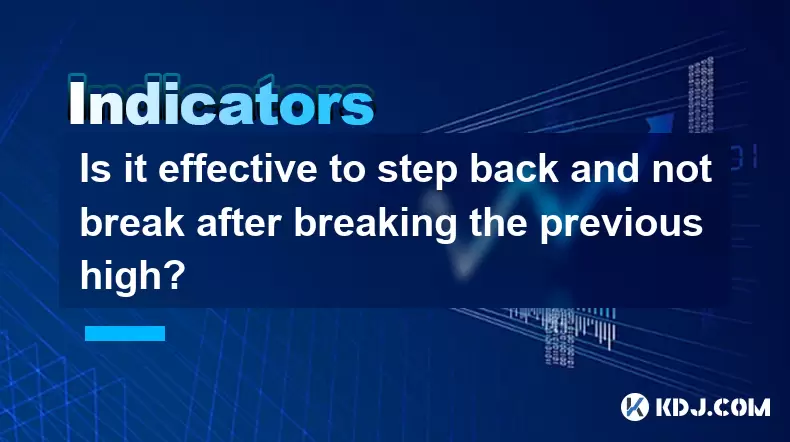
Is it effective to step back and not break after breaking the previous high?
Jun 27,2025 at 05:01am
Understanding the Concept of Breaking Previous HighsIn cryptocurrency trading, breaking a previous high refers to when an asset's price surpasses its last recorded peak. This is often seen as a sign of strong momentum and bullish sentiment. Traders closely monitor these levels because they can indicate potential trend continuation or reversal points. Wh...
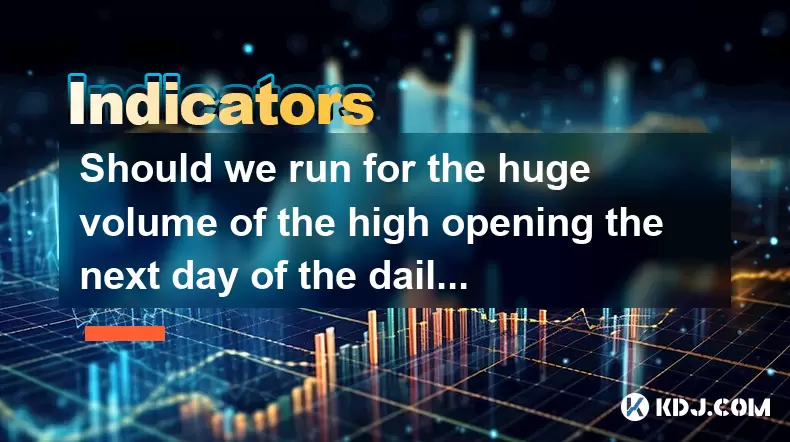
Should we run for the huge volume of the high opening the next day of the daily limit?
Jun 27,2025 at 06:07am
Understanding Daily Limits in Cryptocurrency TradingIn the world of cryptocurrency trading, daily limits refer to price restrictions imposed by exchanges or self-imposed by traders to manage volatility and risk. A daily limit up occurs when the price of a digital asset rises to the maximum allowable percentage within a single trading day. This phenomeno...

The monthly KDJ low-level golden cross is suitable for mid-term position building?
Jun 27,2025 at 03:14am
Understanding the Monthly KDJ IndicatorThe KDJ indicator, also known as the stochastic oscillator, is a momentum tool widely used in technical analysis within the cryptocurrency market. It consists of three lines: the K line, the D line, and the J line. These lines help traders identify overbought or oversold conditions, potential trend reversals, and e...

Is it time to leave the market after breaking through the 60-day line and rebounding?
Jun 27,2025 at 06:29am
Understanding the 60-Day Moving Average in CryptocurrencyIn cryptocurrency trading, technical indicators play a pivotal role in decision-making. Among these, the 60-day moving average is widely used by both novice and experienced traders. This indicator calculates the average price of an asset over the last 60 days and helps identify long-term trends. W...

Is the high-level long upper shadow line with large volume a signal of reaching the top?
Jun 27,2025 at 04:50am
Understanding the High-Level Long Upper Shadow LineIn technical analysis within the cryptocurrency market, candlestick patterns play a crucial role in predicting price movements. A high-level long upper shadow line, often referred to as a shooting star or inverted hammer, is a specific type of candlestick pattern that appears at the top of an uptrend. T...

Can I chase the long positive line that breaks through the 60-day line with large volume at the bottom?
Jun 27,2025 at 07:08am
Understanding the 60-Day Line in Cryptocurrency TradingIn cryptocurrency trading, technical analysis plays a pivotal role in identifying potential entry and exit points. One of the commonly used tools is the 60-day moving average, often referred to as the 60-day line. This indicator smooths out price data over the last 60 days and helps traders determin...

Is it effective to step back and not break after breaking the previous high?
Jun 27,2025 at 05:01am
Understanding the Concept of Breaking Previous HighsIn cryptocurrency trading, breaking a previous high refers to when an asset's price surpasses its last recorded peak. This is often seen as a sign of strong momentum and bullish sentiment. Traders closely monitor these levels because they can indicate potential trend continuation or reversal points. Wh...

Should we run for the huge volume of the high opening the next day of the daily limit?
Jun 27,2025 at 06:07am
Understanding Daily Limits in Cryptocurrency TradingIn the world of cryptocurrency trading, daily limits refer to price restrictions imposed by exchanges or self-imposed by traders to manage volatility and risk. A daily limit up occurs when the price of a digital asset rises to the maximum allowable percentage within a single trading day. This phenomeno...
See all articles
























































































